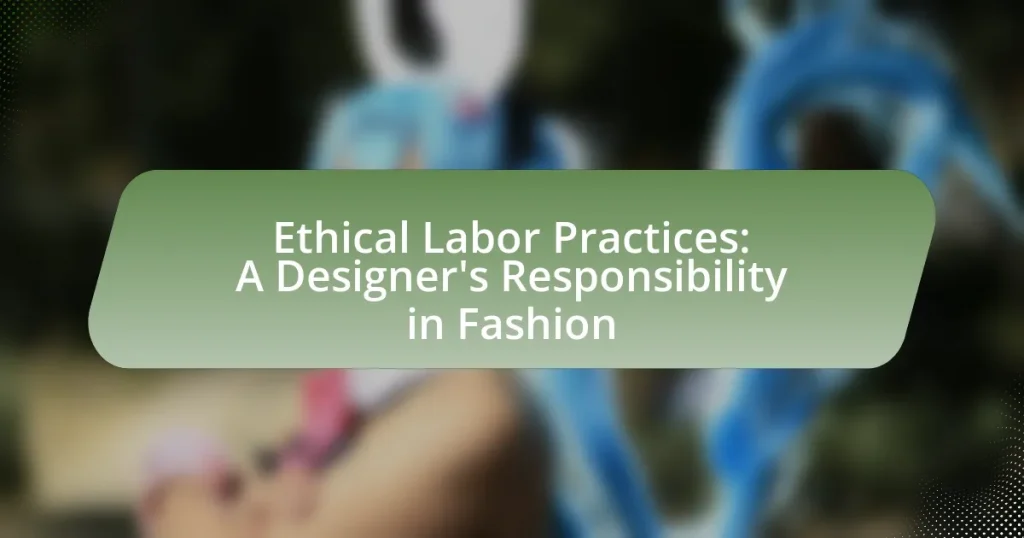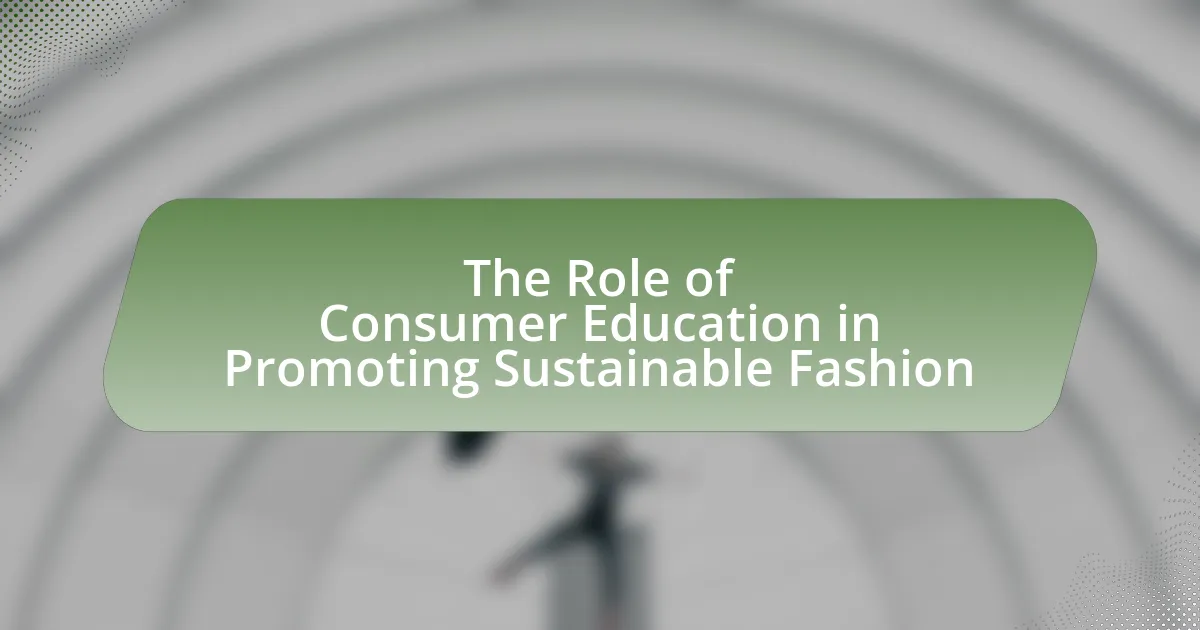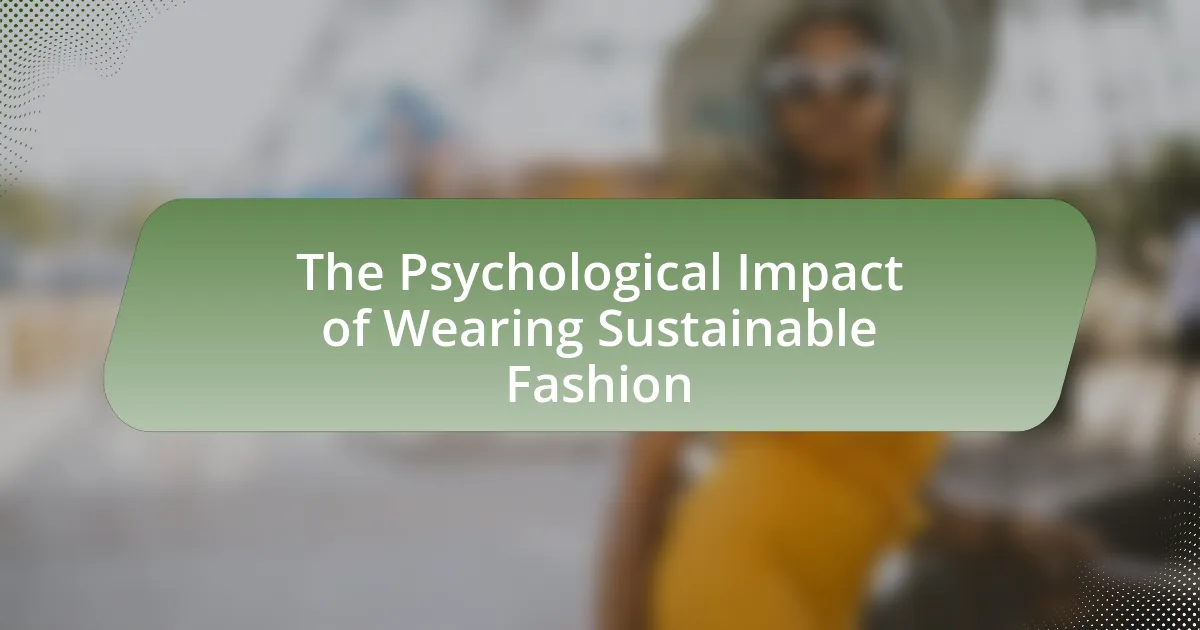Ethical labor practices in fashion encompass standards that ensure fair treatment, safe working conditions, and equitable wages for workers in the industry. This article explores the significance of these practices for designers, highlighting their role in influencing supply chains and promoting sustainability. It discusses the impact of ethical labor practices on brand reputation and consumer behavior, as well as the consequences of neglecting these standards. Key principles such as fair wages, safe working conditions, and non-discrimination are examined, along with strategies for designers to implement ethical sourcing and transparency in their supply chains. The article also addresses the challenges designers face in upholding these practices and the importance of education and collaboration in fostering a responsible fashion industry.

What are Ethical Labor Practices in Fashion?
Ethical labor practices in fashion refer to the standards and actions taken to ensure fair treatment, safe working conditions, and equitable wages for workers in the fashion industry. These practices include paying a living wage, providing safe and healthy working environments, ensuring reasonable working hours, and prohibiting child labor and forced labor. According to the Ethical Trading Initiative, companies that adopt ethical labor practices not only comply with legal standards but also contribute to the well-being of workers and communities, fostering sustainable development.
Why are Ethical Labor Practices Important for Designers?
Ethical labor practices are important for designers because they ensure fair treatment and safe working conditions for all individuals involved in the production process. Designers play a crucial role in influencing the supply chain, and by advocating for ethical practices, they contribute to the well-being of workers and promote sustainability in the fashion industry. Research indicates that brands adhering to ethical labor standards can enhance their reputation, leading to increased consumer trust and loyalty, as evidenced by a 2021 survey where 70% of consumers expressed a preference for brands that prioritize ethical practices.
How do Ethical Labor Practices impact the fashion industry?
Ethical labor practices significantly enhance the reputation and sustainability of the fashion industry. By ensuring fair wages, safe working conditions, and respect for workers’ rights, brands can foster consumer trust and loyalty. For instance, a 2021 survey by McKinsey & Company found that 66% of consumers are willing to pay more for sustainable brands, indicating a direct correlation between ethical practices and consumer purchasing behavior. Furthermore, companies that adopt ethical labor practices often experience reduced turnover rates and increased productivity, as workers are more motivated and engaged in a positive work environment. This creates a competitive advantage in a market increasingly driven by social responsibility and transparency.
What are the consequences of ignoring Ethical Labor Practices?
Ignoring ethical labor practices leads to severe consequences, including legal repercussions, damage to brand reputation, and negative impacts on employee morale. Companies that fail to adhere to ethical standards may face lawsuits and fines, as evidenced by the 2013 Rana Plaza disaster, which resulted in significant legal actions against brands for labor violations. Additionally, consumers increasingly prioritize ethical practices, and brands that ignore these standards risk losing customer trust and loyalty, as shown by a 2021 survey indicating that 70% of consumers are willing to pay more for sustainable products. Furthermore, neglecting ethical labor practices can lead to high employee turnover and low productivity, as workers in unethical environments often experience dissatisfaction and disengagement.
What are the Key Principles of Ethical Labor Practices?
The key principles of ethical labor practices include fair wages, safe working conditions, respect for workers’ rights, and non-discrimination. Fair wages ensure that employees receive compensation that meets or exceeds the living wage standards, promoting economic stability. Safe working conditions mandate that employers provide environments free from hazards, thereby protecting the health and well-being of workers. Respect for workers’ rights encompasses the right to organize, engage in collective bargaining, and express grievances without fear of retaliation. Non-discrimination ensures equal treatment regardless of race, gender, age, or other characteristics, fostering an inclusive workplace. These principles are supported by international labor standards set by organizations such as the International Labour Organization, which advocates for decent work and social justice globally.
How do fair wages contribute to Ethical Labor Practices?
Fair wages are essential to ethical labor practices as they ensure that workers receive compensation that reflects their contributions and sustains their livelihoods. By providing fair wages, companies demonstrate a commitment to social responsibility, which fosters a positive work environment and enhances employee morale. Research indicates that organizations paying fair wages experience lower turnover rates and higher productivity, as employees feel valued and motivated. For instance, a study by the International Labour Organization found that fair compensation leads to improved job satisfaction and loyalty among workers, reinforcing the ethical standards within labor practices.
What role does safe working conditions play in Ethical Labor Practices?
Safe working conditions are fundamental to ethical labor practices as they ensure the health and well-being of workers. When designers prioritize safety, they contribute to a work environment that minimizes hazards, reduces accidents, and promotes mental and physical health. Research indicates that companies with robust safety protocols experience lower injury rates, which not only protects workers but also enhances productivity and morale. For instance, the Occupational Safety and Health Administration (OSHA) reports that effective safety programs can reduce workplace injuries by 20-40%. Thus, safe working conditions are essential for upholding ethical labor standards and fostering a responsible fashion industry.

How Can Designers Implement Ethical Labor Practices?
Designers can implement ethical labor practices by ensuring fair wages, safe working conditions, and transparency in their supply chains. By collaborating with certified ethical manufacturers, designers can guarantee that workers receive appropriate compensation and work in environments that adhere to safety regulations. For instance, the Fair Trade certification requires compliance with specific labor standards, which can serve as a benchmark for designers. Additionally, conducting regular audits and engaging in direct communication with workers can help identify and address labor issues effectively. According to the Ethical Fashion Report, brands that prioritize ethical labor practices not only enhance their reputation but also contribute to sustainable development in the fashion industry.
What steps can designers take to ensure ethical sourcing?
Designers can ensure ethical sourcing by conducting thorough research on suppliers and materials, prioritizing transparency in their supply chains. This involves verifying that suppliers adhere to labor laws and environmental standards, which can be achieved through audits and certifications such as Fair Trade or Global Organic Textile Standard (GOTS). Additionally, designers should establish long-term relationships with suppliers who demonstrate ethical practices, as this fosters accountability and encourages sustainable methods. According to a 2021 report by the Ethical Fashion Initiative, brands that engage in ethical sourcing not only enhance their reputation but also contribute to improved working conditions for laborers, thereby reinforcing the importance of responsible sourcing in the fashion industry.
How can designers verify the labor practices of their suppliers?
Designers can verify the labor practices of their suppliers by conducting audits and assessments that evaluate compliance with labor standards. These audits can include on-site inspections, interviews with workers, and reviewing documentation related to wages, working hours, and safety conditions. According to the Ethical Trading Initiative, regular audits help ensure that suppliers adhere to ethical labor practices, thereby reducing the risk of exploitation. Additionally, designers can utilize third-party certification programs, such as Fair Trade or SA8000, which provide independent verification of labor practices, ensuring that suppliers meet established ethical standards.
What certifications should designers look for in ethical sourcing?
Designers should look for certifications such as Fair Trade, Global Organic Textile Standard (GOTS), and OEKO-TEX Standard 100 in ethical sourcing. Fair Trade certification ensures that producers receive fair wages and work in safe conditions, promoting sustainable practices. GOTS certification guarantees that textiles are made from organic fibers and adhere to strict environmental and social criteria throughout the supply chain. OEKO-TEX Standard 100 certifies that textiles are free from harmful substances, ensuring safety for consumers and workers alike. These certifications provide a framework for ethical sourcing, supporting responsible labor practices in the fashion industry.
How can collaboration enhance Ethical Labor Practices?
Collaboration can enhance ethical labor practices by fostering transparency and accountability among stakeholders in the fashion industry. When designers, manufacturers, and suppliers work together, they can establish shared standards and practices that prioritize fair wages, safe working conditions, and sustainable sourcing. For instance, partnerships between brands and non-profit organizations have led to the implementation of fair trade certifications, which ensure that workers receive equitable compensation and are treated with dignity. Research from the Ethical Trading Initiative shows that collaborative efforts in supply chains can reduce labor violations by up to 30%, demonstrating the effectiveness of collective action in promoting ethical labor standards.
What partnerships can designers form to promote ethical labor?
Designers can form partnerships with ethical fashion brands, labor rights organizations, and sustainable material suppliers to promote ethical labor. Collaborating with ethical fashion brands allows designers to align their practices with companies that prioritize fair wages and safe working conditions. Partnering with labor rights organizations, such as the Fair Labor Association, provides designers with resources and advocacy to ensure compliance with labor standards. Additionally, working with sustainable material suppliers can help designers source ethically produced fabrics, further supporting responsible labor practices in the fashion industry. These partnerships collectively enhance the commitment to ethical labor and contribute to a more sustainable fashion ecosystem.
How can industry organizations support designers in ethical practices?
Industry organizations can support designers in ethical practices by establishing clear guidelines and standards for ethical design, providing resources for education and training, and facilitating collaboration among designers to share best practices. For instance, organizations like the Ethical Fashion Forum offer frameworks that help designers understand sustainable materials and labor practices. Additionally, industry organizations can create certification programs that recognize and promote ethical design, thereby incentivizing designers to adhere to these standards. This structured support not only enhances the designers’ knowledge but also fosters a culture of accountability and transparency within the fashion industry.

What Challenges Do Designers Face in Upholding Ethical Labor Practices?
Designers face significant challenges in upholding ethical labor practices, primarily due to the complexities of global supply chains. These supply chains often involve multiple tiers of production, making it difficult for designers to monitor labor conditions and ensure compliance with ethical standards. For instance, a report by the Ethical Fashion Initiative highlights that many designers lack transparency in their supply chains, which can lead to unintentional support of exploitative labor practices. Additionally, cost pressures from fast fashion demand can compel designers to prioritize lower production costs over ethical considerations, further complicating their ability to maintain ethical labor practices.
What are the common obstacles to implementing Ethical Labor Practices?
Common obstacles to implementing ethical labor practices include cost constraints, lack of transparency in supply chains, and insufficient regulatory frameworks. Cost constraints often deter companies from adopting fair labor practices, as ethical sourcing can be more expensive than traditional methods. Lack of transparency in supply chains complicates the ability to monitor labor conditions, making it difficult for designers to ensure compliance with ethical standards. Additionally, insufficient regulatory frameworks can lead to inconsistent enforcement of labor laws, allowing unethical practices to persist. These factors collectively hinder the effective implementation of ethical labor practices in the fashion industry.
How do cost pressures affect designers’ commitment to ethical practices?
Cost pressures significantly diminish designers’ commitment to ethical practices. When faced with financial constraints, designers often prioritize cost reduction over ethical considerations, leading to compromises in labor standards and sustainability. A study by the Ethical Fashion Forum found that 70% of designers reported feeling pressured to cut costs, which frequently resulted in sourcing materials from suppliers with poor labor practices. This trend illustrates how economic factors can directly influence ethical decision-making in the fashion industry.
What role does consumer demand play in shaping ethical practices?
Consumer demand significantly influences the development of ethical practices in the fashion industry. When consumers prioritize sustainability and ethical labor, brands are compelled to adopt responsible sourcing, fair wages, and environmentally friendly production methods to meet these expectations. For instance, a 2021 survey by McKinsey & Company found that 67% of consumers consider sustainability when making a purchase, prompting brands to integrate ethical practices into their business models to remain competitive. This shift in consumer behavior drives companies to enhance transparency and accountability, ultimately shaping industry standards for ethical labor practices.
How can designers overcome these challenges?
Designers can overcome challenges related to ethical labor practices by implementing transparent supply chain management. By actively engaging with suppliers and ensuring fair labor conditions, designers can promote ethical standards. Research indicates that brands adopting transparency report a 20% increase in consumer trust, which can lead to higher sales and brand loyalty. Furthermore, designers can collaborate with organizations that specialize in ethical labor practices, such as the Ethical Trading Initiative, to gain insights and resources for improving their practices. This proactive approach not only addresses ethical concerns but also aligns with growing consumer demand for responsible fashion.
What strategies can designers adopt to balance ethics and profitability?
Designers can adopt strategies such as sustainable sourcing, transparent supply chains, and ethical labor practices to balance ethics and profitability. Sustainable sourcing involves selecting materials that are environmentally friendly and ethically produced, which can attract consumers who prioritize sustainability, thereby increasing sales. Transparent supply chains allow designers to showcase their commitment to ethical practices, enhancing brand loyalty and consumer trust. Ethical labor practices, including fair wages and safe working conditions, not only improve the lives of workers but also resonate with socially conscious consumers, potentially leading to higher profitability. Research indicates that brands with strong ethical commitments can experience a 20% increase in customer loyalty, demonstrating that ethical practices can directly contribute to financial success.
How can education and awareness improve ethical practices in fashion?
Education and awareness can significantly improve ethical practices in fashion by equipping designers and consumers with the knowledge to make informed decisions. When designers understand the implications of their sourcing and production methods, they are more likely to adopt sustainable practices that prioritize fair labor conditions. For instance, a study by the Ethical Fashion Forum found that 70% of consumers are willing to pay more for ethically produced clothing when they are aware of the social and environmental impacts of fast fashion. This awareness drives demand for transparency and accountability in the industry, prompting brands to implement ethical labor practices. Furthermore, educational initiatives can foster a culture of responsibility among emerging designers, encouraging them to prioritize ethics in their work from the outset.
What are the best practices for designers to follow in Ethical Labor Practices?
Designers should prioritize transparency, fair wages, and sustainable sourcing as best practices for ethical labor practices. Transparency involves openly sharing information about supply chains and labor conditions, which builds trust with consumers and stakeholders. Fair wages ensure that all workers receive compensation that meets or exceeds living wage standards, promoting economic stability and dignity. Sustainable sourcing means selecting materials and production methods that minimize environmental impact and support ethical labor conditions. According to the Ethical Fashion Report, brands that adopt these practices not only enhance their reputation but also contribute to a more equitable fashion industry.
How can designers create a transparent supply chain?
Designers can create a transparent supply chain by implementing traceability systems that track the origin and journey of materials used in their products. This involves utilizing technologies such as blockchain to record every step of the supply chain, ensuring that information about sourcing, labor conditions, and environmental impact is accessible and verifiable. For instance, brands like Everlane and Patagonia have adopted such practices, allowing consumers to see the cost breakdown and ethical standards of their products. This transparency not only builds consumer trust but also holds suppliers accountable, fostering ethical labor practices in the fashion industry.
What tools and resources are available for designers to promote ethical labor?
Designers can utilize various tools and resources to promote ethical labor, including certifications, platforms for ethical sourcing, and educational resources. Certifications such as Fair Trade and Global Organic Textile Standard (GOTS) provide guidelines and standards for ethical practices in labor and sourcing. Platforms like Ethical Fashion Forum and Good On You offer directories of ethical brands and suppliers, enabling designers to make informed choices. Additionally, educational resources such as the Fashion Revolution’s “Who Made My Clothes?” campaign raise awareness about labor practices and encourage transparency in the fashion industry. These tools collectively empower designers to advocate for and implement ethical labor practices effectively.




